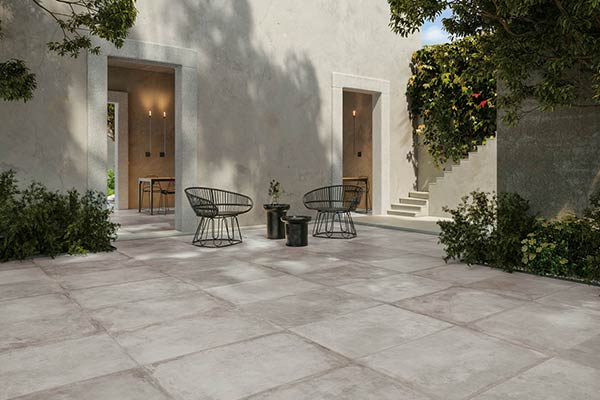
The qualities of your outdoor tiles can be affected by the elements. To mitigate the effects of the elements when laying your tiles, certain conditions must be respected. One of these is temperature. It’s therefore important to consider the ideal temperature for laying tiles, and the perfect season for doing so. Temperatures are not the same all year round.
Ideal temperatures for laying outdoor tiles
Depending on the temperature, professionals recommend that you lay your tiles all at once. This recommendation is particularly valid for temperatures below 5°C. This can be done in a few hours if conditions are favourable.
On the other hand, if the weather is wet, you will have no choice but to carry out this operation in several stages. In this case, you need to be careful not to get the tiles and your materials wet.
Similarly, if you’re using adhesive, make sure it’s suitable for temperatures as low as -10°C.
This is because outdoor tiling has a number of disadvantages and is difficult to maintain. What’s more, damp and frost can affect its resistance over the years.
The ideal season for laying outdoor tiles
Weather conditions are not the same in all seasons. Laying tiles is not the same at all times of the year. Technical conditions are subject to change, and it is essential to respect them if you want your tiles to be hard-wearing.
Laying outdoor tiles in winter
There are several factors to take into account when laying outdoor tiles in winter. The main ones are humidity levels and air temperature, which can have an impact on installation techniques.
In sub-zero temperatures, outdoor tiles cannot be laid without an insulating underlay. It is complicated to work on frozen or damp ground. The surface must be perfectly dry for a smooth, healthy covering.
Another option is to opt for a covering that is resistant to adverse weather conditions. Novoceram porcelain stoneware tiles are an excellent alternative.
Your floor covering, especially in winter, must comply with certain standards. These include the UNI E 010 standard for average resistance to atmospheric agents.
Laying outdoor tiles in spring
Even if the weather and temperatures are milder in spring, certain conditions must be respected.
The weather must not be damp or rainy. If this is the case, it’s best to stop the installation to protect your tiles and your equipment.
In the event of extreme temperatures, frost or heatwave, the floor should be well covered and protected.
Laying outdoor tiles in autumn
When laying outdoor tiles in autumn, you should expect temperatures of between 12 and 15°C. These temperatures generally give your floor an optimal covering. Nevertheless, be sure to test the adhesive to ensure that the tiles set properly.
You should also bear in mind the drying time, which varies according to the ambient temperature. Full drying will take several days. During this drying time, make sure the weather conditions are optimal.
Laying outdoor tiles in summer
Generally speaking, the ideal temperature for laying your outdoor tiles should not exceed 35°C. Temperatures higher than this are extreme and can affect the quality of your tiles.
To avoid this, especially in areas in the south of France, you should thoroughly wet your surface.
The choice of tiles is important in summer. You need to consider the possible uses of the flooring in question.
Covering your floor with outdoor tiles requires a non-slip, hard-wearing material. However, for tight spaces in your outdoor area, it’s important to use less hard-wearing tiles. What’s more, the materials you choose should be easy to maintain.
FAQ
Here are some answers to the most frequently asked questions about laying outdoor tiles.
What should I do to protect my tiles from frost?
When tiles are laid, they must be resistant to frost. This is the EN 2020 standard. What’s more, to protect against frost, the porosity of your tiles must not exceed 3%.
How can I protect my tiles from rainwater infiltration in winter?
deally, when laying your outside tiles, you should opt for a liquid waterproofing system (LWTS).
When laying your tiles, it’s essential to respect the temperature ranges. These should be between 5 and 35°C. The open times of adhesives often change according to climatic conditions.
Is Novoceram porcelain stoneware a solution?
Absolutely, Novoceram’s 20 mm exterior tiles are the ideal product for preserving the original appearance of your terrace, regardless of weather conditions.
Porcelain stoneware is resistant to frost, extreme temperatures and bad weather. What’s more, its exterior appearance resists the wear and tear of time.
As a result, this range boasts features that are unique on the market. Porcelain stoneware is ingenious and can withstand extreme temperatures ranging from -50 to 60°.
You can also opt to lay your tiles on blocks. This system is easier to maintain, with repositionable tiles that can be used to install pipes and a lighting system.
It’s important to remember that your floor covering must be laid properly if it is to withstand temperatures properly.
For sealed installation, a drainage system and a 2% slope are required. For glue-down installation, on the other hand, the slope facing outwards should be 1.5%. Tile joints are also compulsory. They provide effective protection for your tiles.




